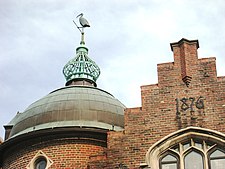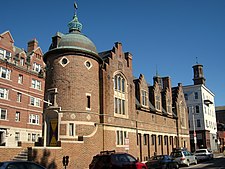Harvard Lampoon Building
Harvard Lampoon Building | |
 (2017) | |
| Location | 44 Bow Street Cambridge, Massachusetts |
|---|---|
| Coordinates | 42°22′17.8″N 71°7′2.5″W / 42.371611°N 71.117361°W |
| Built | 1909 |
| Architect | Edmund M. Wheelwright |
| Architectural style | Mock Flemish |
| NRHP reference No. | 78000440[1] |
| Added to NRHP | March 30, 1978 |
The Harvard Lampoon Building (sometimes referred to as the Lampoon Castle) is a historic building in Cambridge, Massachusetts, which is best known as the home of The Harvard Lampoon, and for its unusual design.
Architecture and design

The building was constructed at 44 Bow Street[1] not far from Harvard Yard and close to the "Gold Coast" of residences for undergraduates of Harvard College before the creation of Harvard's "house system" (some of them now part of Adams House). Designed by Edmund M. Wheelwright, who also oversaw the construction, it was first opened on February 19, 1909. Wheelwright had attended Harvard University and was one of the founders of the Harvard Lampoon.[2] Wheelwright's design was inspired in part by an old church in Jamestown, Virginia,[3] and by the Flemish Renaissance details of Auburn Street buildings in its vicinity. The building has been described as a "Satirical Castle".[4]
During the construction phase of the project he traveled to Europe to procure appropriate furnishings and windows. He purchased leaded windows in Belgium and an Elizabethan mantelpiece in England.[2] The building also features 17th-century Delft tiles that were imported from the Netherlands.[3] The Delft tiles are blue, white, and aubergine. The tiles were used in a room with an open ceiling and plain furniture and timbers.[5]
The ground floor features a small entrance and a round library used for editorial meetings. The floor opens up and there is a secret chamber beneath the library (a "basement") used for "secret" events.
The building features a copper ibis, symbol of the Lampoon, mounted on the top of the dome. The statue is roughly 4 feet (1.2 m) high and weighs roughly 70 pounds (32 kg). Though it was first installed in 1909, it has frequently been stolen and returned ever since. On one occasion members of The Harvard Crimson, the student newspaper and rival of the Lampoon, which issues an annual Crimson parody issue, stole the statue and presented it as a gift to the Russian delegation to the UN. After initially promising to install it on top of a building at Moscow State University, the delegation returned the statue.[6]
The building cost approximately $40,000 to construct, making it then the most expensive headquarters of a college newspaper in the United States.[2] After the building was first constructed, it initially hosted a small store on the ground floor in addition to the Harvard Lampoon offices and meeting spaces on the other floors;[3] for years the site housed a used book shop, Starr Books.
Reception
Barrett Wendell once described the building as "sturdily honest as the founder who designed it, yet laughing at every turn with freakish gayety and beauty."[4] However, the building's architecture has been criticized, most notably by former Cambridge mayor Alfred Vellucci. He once described it as "one of the ugliest buildings in the world"[7] and claimed that "it does nothing but scare strangers"[8] and "looks like a witch on a broomstick."[9] He also noted that the location of the building "is an ideal spot for a restroom",[9] and once unsuccessfully proposed a city ordinance declaring the building a public urinal.[7]
The building was added to the National Register of Historic Places in 1978.[1]
Foliage
Vellucci later clashed with the Harvard Lampoon due to a tree that he planted on city land in front of the building in 1961 in order to block the view of the building.[7] He wished to obscure the face of the building because he found it ugly and to avenge local Italian Americans, whom he believed the Lampoon had insulted by claiming that an Irishman (rather than the Italian Christopher Columbus) discovered America.[9] Vellucci's opposition was also fueled in part by the proposal from members of the Harvard Lampoon to rename a nearby intersection "Lampoon Square",[8] and by the satirical portraits of Vellucci that they published.[7]
During the sixties, seventies, and eighties the tree was routinely vandalized, its branches often chopped off and acid was poured on the tree twice. However, in 1991 the tree was completely chopped down. The Harvard Lampoon refused to confirm or deny involvement in the event[10] and a smaller tree was planted in its place.[7] Three years later the tree was felled on the night of Harvard's commencement. The leadership of the Harvard Lampoon denied any complicity, and suggested that it may have been a false flag operation by members of the Harvard Crimson.[10]
Gallery
-
View of Ibis on dome
-
Side view of building
-
View from the rear (west)
-
100th Anniversary celebration
See also
References
- ^ a b c "National Register Information System". National Register of Historic Places. National Park Service. April 15, 2008.
- ^ a b c The American Educational Review. Vol. 31. American Educational Co. 1910. p. 365.
- ^ a b c The Brickbuilder. Vol. 19. Rogers & Manson. 1910. p. 82.
- ^ a b Wald, Alan M. (1983). The revolutionary imagination: the poetry and politics of John Wheelwright and Sherry Mangan. UNC Press Books. p. 40. ISBN 978-0-8078-1535-9.
- ^ Leila Mechlin, ed. (1922). Magazine of art. Vol. 13. American Federation of Arts. p. 182.
- ^ "Harvard Ibis on missing list". The Reading Eagle. 1 July 1988. Retrieved 4 June 2011.
- ^ a b c d e Arnold, David (6 April 1991). "Roots of a quarrel Vellucci, Lampoon wage feud over a tree". The Boston Globe.
- ^ a b Kann, Peter R. (February 12, 1963). "'Turn Lampoon Into Rest Room': Vellucci". The Harvard Crimson. Retrieved October 18, 2019.
- ^ a b c Moran, Edward (9 October 1979). "Tree blocks the Poones". The Boston Globe.
- ^ a b Brelis, Matthew (26 October 1994). "City stumped. Who's axing? Cambridge blames Lampoon for a tree that used to grow". The Boston Globe.
External links
 Media related to Harvard Lampoon Building at Wikimedia Commons
Media related to Harvard Lampoon Building at Wikimedia Commons





